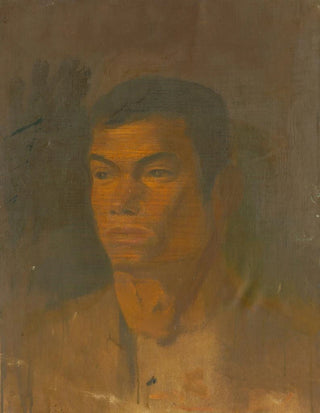Art print | Head of a Romani boy - Ladislav Mednyánszky Source: Reproduction | Tête d'un garçon gitan - Ladislav Mednyánszky


View from behind

Frame (optional)
"Tête d'un garçon gitan" by Ladislav Mednyánszky is a work that transcends the simple portrait to immerse the viewer in a universe rich in emotions and stories. This painting, both intimate and universal, captures the essence of a youth full of promise, while evoking the gypsy culture through the gaze of an artist deeply inspired by human beauty. By contemplating this art print, one enters into a silent dialogue with the boy, whose delicately rendered face seems to tell stories of life, tradition, and resilience. This artwork is an invitation to explore the nuances of the human soul, through the lens of a often misunderstood culture.
Style and uniqueness of the work
Mednyánszky's style is characterized by an exceptional mastery of shadows and lights, which give his portraits a striking depth. In "Tête d'un garçon gitan," the color palette, both soft and vibrant, highlights the features of the young boy's face, emphasizing his penetrating gaze and expressive emotion. The brushstrokes, both delicate and assertive, create a texture that feels almost tangible, inviting the viewer to feel the emotions emanating from this piece. Every detail, whether it concerns the texture of the skin or the reflections in the eyes, is rendered with precision that reflects the artist's meticulous attention. This stylistic singularity makes the work not only a portrait but a true psychological study, a frozen moment in time that invites reflection.
The artist and his influence
Ladislav Mednyánszky, born in 1852 in Hungary, is often regarded as one of the masters of portrait and landscape painting of the 19th century. His training at the Vienna Academy of Fine Arts and his travels across Europe allowed him to refine his style, blending impressionist and realist influences. Mednyánszky was able to capture the essence of his era while highlighting often neglected subjects, such as gypsies and peasants. His work is marked by a deep empathy for those he depicts, and "

Matte finish

View from behind

Frame (optional)
"Tête d'un garçon gitan" by Ladislav Mednyánszky is a work that transcends the simple portrait to immerse the viewer in a universe rich in emotions and stories. This painting, both intimate and universal, captures the essence of a youth full of promise, while evoking the gypsy culture through the gaze of an artist deeply inspired by human beauty. By contemplating this art print, one enters into a silent dialogue with the boy, whose delicately rendered face seems to tell stories of life, tradition, and resilience. This artwork is an invitation to explore the nuances of the human soul, through the lens of a often misunderstood culture.
Style and uniqueness of the work
Mednyánszky's style is characterized by an exceptional mastery of shadows and lights, which give his portraits a striking depth. In "Tête d'un garçon gitan," the color palette, both soft and vibrant, highlights the features of the young boy's face, emphasizing his penetrating gaze and expressive emotion. The brushstrokes, both delicate and assertive, create a texture that feels almost tangible, inviting the viewer to feel the emotions emanating from this piece. Every detail, whether it concerns the texture of the skin or the reflections in the eyes, is rendered with precision that reflects the artist's meticulous attention. This stylistic singularity makes the work not only a portrait but a true psychological study, a frozen moment in time that invites reflection.
The artist and his influence
Ladislav Mednyánszky, born in 1852 in Hungary, is often regarded as one of the masters of portrait and landscape painting of the 19th century. His training at the Vienna Academy of Fine Arts and his travels across Europe allowed him to refine his style, blending impressionist and realist influences. Mednyánszky was able to capture the essence of his era while highlighting often neglected subjects, such as gypsies and peasants. His work is marked by a deep empathy for those he depicts, and "






